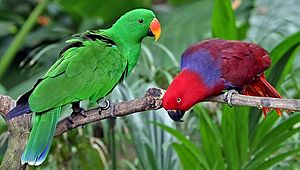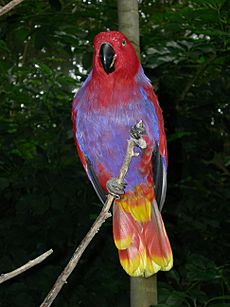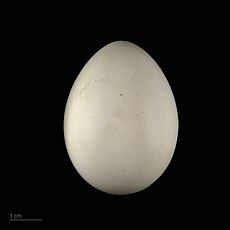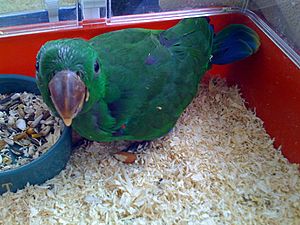Moluccan eclectus facts for kids
Quick facts for kids Moluccan eclectus |
|
|---|---|
 |
|
| Male (left) and female (right) at Singapore Zoo | |
| Conservation status | |
| Scientific classification | |
| Genus: |
Eclectus
|
| Species: |
roratus
|
The Moluccan eclectus (Eclectus roratus) is a beautiful parrot that lives in the Maluku Islands (also called the Moluccas). These islands are part of Indonesia.
What makes this parrot special is how different the males and females look. This is called sexual dimorphism. Male Moluccan eclectus parrots are mostly bright green. Female parrots are mostly bright red and purple or blue. Because they look so different, early ornithologists (bird scientists) thought they were two completely different types of birds!
Many of these parrots still live in the wild. Sometimes, they are even seen as pests because they eat fruit from trees. However, some groups living on smaller islands are quite rare. People in New Guinea also use their bright feathers for decorations.
Contents
About the Moluccan Eclectus Parrot
Scientists usually group the Moluccan eclectus with other parrots in the family Psittacidae. Some recent ideas suggest they might be related to the Lorini tribe, which includes lorikeets.
Different Types of Eclectus Parrots

There are three known types, or subspecies, of the Moluccan eclectus. It's hard to study them all because some areas where they live are difficult to reach.
- E. r. roratus, also known as the grand eclectus, lives on islands like Buru, Seram, Ambon, and Saparua in the southern Maluku Islands.
- E. r. vosmaeri, called Vosmaer's eclectus, is named after a Dutch naturalist, Arnout Vosmaer. This type is bigger and has more yellow in its feathers. Males have more yellow on their heads and necks. Females are a brighter red with yellow feathers under their tails. This is the most common type of eclectus parrot kept as a pet.
- E. r. westermani, or Westerman's eclectus, might have existed a long time ago. However, many scientists think the birds seen were actually mixed types from pet birds. If it was a real subspecies, it is now extinct.
Appearance and Colors
The Moluccan eclectus parrot is unique because the males and females have such different colors. They are stocky parrots with short tails, growing to about 35 cm (14 inches) long.
- Males are mostly bright green. They have a yellow tint on their heads, blue wing feathers, and red feathers under their wings. Their tails are edged with a narrow band of creamy yellow.
- Females are mostly bright red. Their backs and wings are a darker red, sometimes purple. Their wings have a mauve-blue edge. Their tails are edged with yellowish-orange.
The beak of an adult male is orange at the top and black at the bottom. The beak of an adult female is all black. Adult parrots have yellow or orange eyes, while young parrots have dark brown or black eyes.
Most female eclectus parrots have blue bellies and necks. However, the roratus type has a purple belly and neck, and the vosmaeri type has a lavender belly and neck. The female vosmaeri is also the brightest red of all the types.
Sometimes, a rare blue color appears in pet eclectus parrots. This happens because of a special gene. The male bird will be light blue, and the female will be dark blue, white, and grey.
Diet and Food
In the wild, Moluccan eclectus parrots mostly eat fruits, wild figs, nuts that aren't ripe yet, flower buds, and some seeds.
When kept as pets, they can eat many fruits like mangos, figs, guavas, bananas, melons, grapes, citrus fruits, pears, apples, and papaya. These parrots have a long digestive system, which means they can handle a lot of fiber in their food. Pet eclectus parrots also benefit from special bird pellets, vegetables, and leafy greens like dandelion. They can also have a small amount of nuts like almonds and walnuts.
Reproduction and Life Cycle
In their natural home, Moluccan eclectus parrots build their nests inside hollows of large rainforest trees. Good nesting spots are hard to find. The female parrot will strongly protect her chosen nest from other females, sometimes even fighting them. She stays near her nest for up to 11 months of the year.
She relies on several males to bring her food. Males might fly up to 20 km (12 miles) to find food. Up to five males will regularly feed one female, each trying to be the one to father her chicks. Unlike many other parrots, female eclectus parrots may mate with several males. Males may also mate with several females.
This unique way of breeding might explain why males and females look so different. The female needs to be easily seen at the nest entrance to show other males and females that the spot is taken. But when she's deep inside the dark nest, her red color helps her hide. The male is bright green, which helps him blend in with the trees while he's looking for food. Both male and female feathers also look amazing under ultraviolet light, which predators like hawks and owls cannot see.
Females lay two white eggs, which are about 40 mm by 31 mm (1.6 inches by 1.2 inches). The eggs hatch after 28–30 days. The young birds are ready to leave the nest when they are about 11 weeks old. Eclectus parrots usually become old enough to have their own chicks between 2 and 3 years of age.
Female Moluccan eclectus parrots have a very strong motherly instinct. Even in captivity, they will look for places to nest, like cupboards or drawers. They become very protective of these spots. A female parrot without a mate might even lay eggs that won't hatch if she feels like nesting. It's often possible to give abandoned eggs from other parrot species to a female eclectus, and she will care for them as if they were her own.
Eclectus Parrots as Pets
Moluccan eclectus parrots are popular pets. They are generally calm birds. Sometimes, they seem a bit shy or careful when they see new things. They can also be more afraid of new things than other pet birds.
The E. r. vosmaeri type is the most common eclectus parrot kept as a pet.
The average lifespan of a Moluccan eclectus parrot in captivity is not fully known. This is because they only became popular pets in large numbers in the 1980s. Some people believe they can live for 30 years. The longest reliably recorded lifespan for this parrot is 28.5 years, but some have been reported to live for 40.8 years.
Pet Moluccan eclectus parrots can sometimes do something called "toe tapping." This is when they can't control their foot muscles and constantly tap their toenails against their perch. Scientists think this might be related to their diet, especially if they eat foods with too many added vitamins or human processed foods.
See also
 In Spanish: Loro eclecto para niños
In Spanish: Loro eclecto para niños





